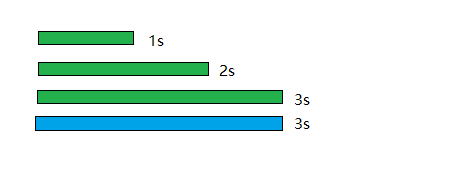模拟微服务并行调用外部接口
假如一个RPC接口需要依赖另外三个服务的功能,如果三个服务的响应时间假设分别为3秒、1秒、2秒,这时候如果顺序执行需要6秒的时间。如果依赖的服务逐渐增多,那么响应的时间也会越来越长。

如果让三个服务并行执行,那么这个接口理论上响应时间为3秒。

- 如果接口调用不关心返回值,则可以使用异步的方式;
- 如果接口调用需要返回值,则需要采用并行执行;
本文模拟需要返回值,采用并行线程,减少RPC接口响应时间。
创建3个模拟RPC服务接口
private static String getUser() {
//模拟查询需要两秒
try {
Thread.sleep(2000);
} catch (InterruptedException e) {
e.printStackTrace();
}
return "张三";
}
private static String getClasz() {
//模拟查询需要3秒
try {
Thread.sleep(3000);
} catch (InterruptedException e) {
e.printStackTrace();
}
return "1班";
}
private static String getAddress() {
//模拟查询需要1秒
try {
Thread.sleep(1000);
} catch (InterruptedException e) {
e.printStackTrace();
}
return "深圳";
}
如果我们采用顺序执行,执行时间大约6s.
private static void test() {
long start = System.currentTimeMillis();
System.out.println(getUser());
System.out.println(getClasz());
System.out.println(getAddress());
long end = System.currentTimeMillis();
System.out.println("执行时间为: " + (end - start));
}

这里提供两种方法
- Future
private static void test01() {
long start = System.currentTimeMillis();
CountDownLatch countDownLatch = new CountDownLatch(3);
ExecutorService es = Executors.newFixedThreadPool(3);
Future getUserInfo = es.submit(() -> {
String user = getUser();
countDownLatch.countDown();
return user;
});
Future getClaszInfo = es.submit(() -> {
String clasz = getClasz();
countDownLatch.countDown();
return clasz;
});
Future getAddressInfo = es.submit(() -> {
String address = getAddress();
countDownLatch.countDown();
return address;
});
try {
//同步等待所有线程执行完之后再继续
countDownLatch.await();
System.out.println(getUserInfo.get());
System.out.println(getClaszInfo.get());
System.out.println(getAddressInfo.get());
} catch (Exception e) {
e.printStackTrace();
} finally {
es.shutdown();
}
long end = System.currentTimeMillis();
System.out.println("执行时间为: " + (end - start));
}
执行时间为3秒多,效率明显上去了。

- CompletableFutures
private static void test02() {
long start = System.currentTimeMillis();
CompletableFuture<String> getUserInfo = CompletableFuture.supplyAsync(() -> {
return getUser();
});
CompletableFuture<String> getClaszInfo = CompletableFuture.supplyAsync(() -> {
try {
return getClasz();
}catch (Exception e){
return e.toString();
}
});
CompletableFuture<String> getAddressInfo = CompletableFuture.supplyAsync(() -> {
return getAddress();
});
CompletableFuture.allOf(getUserInfo, getClaszInfo, getAddressInfo);
try {
System.out.println(getUserInfo.get());
System.out.println(getClaszInfo.get());
System.out.println(getAddressInfo.get());
} catch (InterruptedException e) {
e.printStackTrace();
} catch (ExecutionException e) {
e.printStackTrace();
}
long end = System.currentTimeMillis();
System.out.println("执行时间为: " + (end - start));
}
响应速度也是3秒多,效率与顺序执行相比提高了一半。
